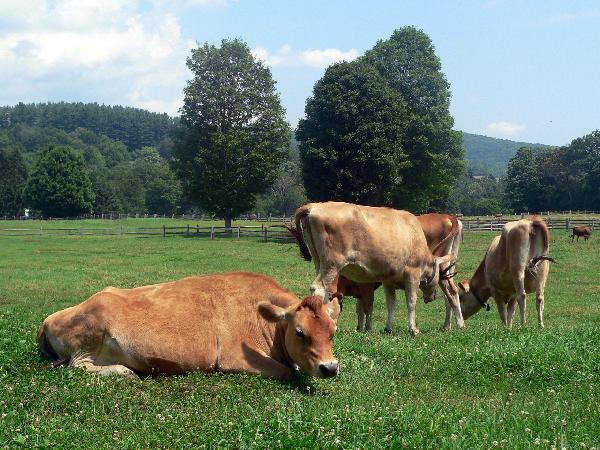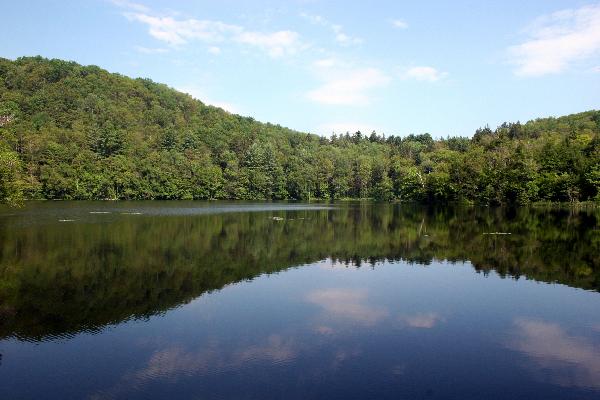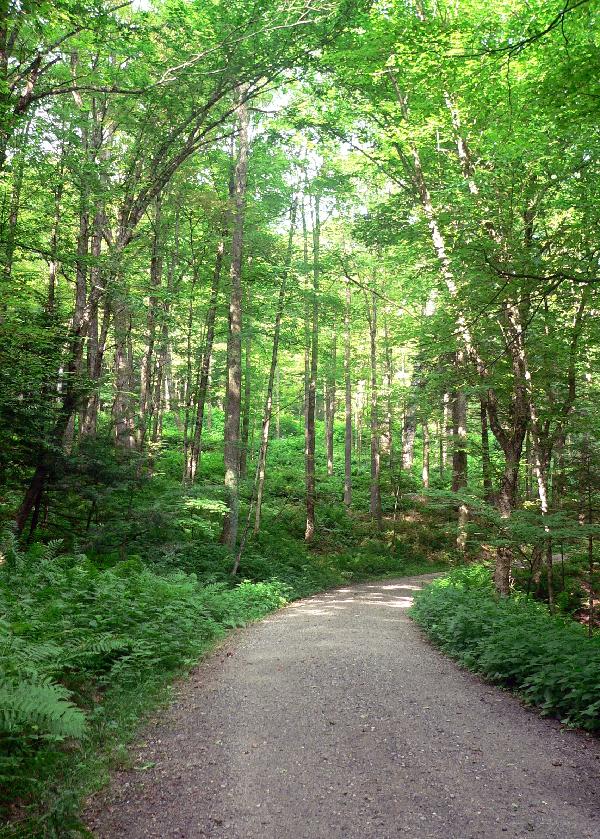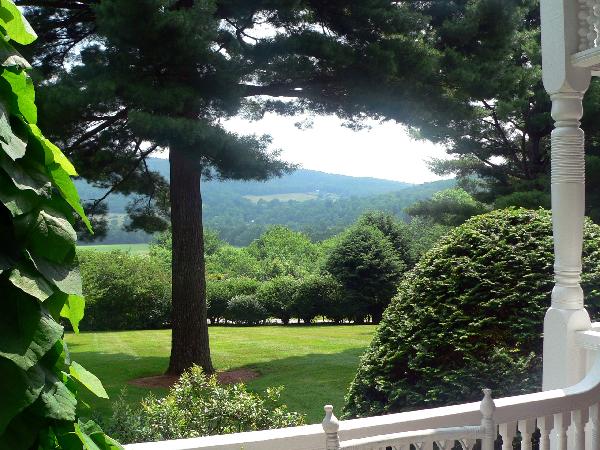Woodstock, Vt.
NPS Website; Local Website

WHAT IS IT?
Site dedicated to the three generations of American families (ID'd in the Park's name) who inhabited the estate’s Richardson Romanesque mansion and the adjacent 555 acres of managed forest. Next door to the National Park Site is the privately-run and better known Billings Farm and Museum, which tells the story of Vermont farm life.
BEAUTY (7/10)
The Marsh-Billings-Rockefeller NHP consists of two distinct parts: the area in and around the Billings Mansion (permissible only with a tour ticket) and the surrounding forest (accessible for free via carriage road trails).
The insides of the Mansion hold nearly all of the Park's charm and beauty; Mr. Billings was one tasteful railroad baron. Up until his death in 1890, Billings amassed what still ranks among the finest private collections of 19th Century American art. Amazingly, Billings bought all but three of the paintings from the artists themselves. Coles, Bierstadts and Durands hang throughout the mansion, a perfect representation of American landscape art, our nation's first endemic art form. Billings' decorations are subtle, understated and confident in ways that escape most Victorian-era robber baron mansions; a classy counterpoint to the garishness of the Biltmore in Asheville, N.C. or Newport, R.I.'s countless monstrosities.
The forest is attractive in the same way that golf courses are attractive. Every tree is “managed” by experts, the undergrowth is excessively maintained, many of the trees are transplanted (and, gasp, non-native), it is green and wide carriage roads hustle you to exactly where you need to be. You are in nature but then again you are not in the wild. The outdoor land's centerpiece is the idyllic pond coarsely dubbed The Pogue. The pond's small, peaceful nature is reminiscent of the mind's eye's vision of Thoreau's Walden Pond.

HISTORICAL INTEREST (3/10)
The mansion's first resident, George Perkins Marsh, would certainly be shocked at his historical remembrance, especially considering that he is honored side-by-side with Billings and a member of the Rockefeller clan. He might even be more shocked that they are all remembered under the umbrella of promoting conservation and environmentalism.
During the 1840's Marsh grew increasingly aghast at America's antebellum industrial revolution onslaught. He, akin to the transcendentalist authors of the same period, was repulsed by the widespread ecological destruction done in the name of progress and civilization; loggers were ravenously felling every tree in the Vermont countryside. So, in turn, he obtained a diplomatic post in Italy (during the American Civil War no less), wrote a dry tome, apparently a precursor the environmental movement, entitled Man and Nature and never returned to the United States.
When Frederick Billings purchased the Mansion in 1869 the surrounding countryside had been ravaged by loggers. So, in turn, he planted a few trees in his backyard, managed its contents and started a small dairy farm. We remain unclear as to what this has to do with conservation. The Site also never delved into the environmental ramifications wrought by the expansion of Billings' Northern Pacific Railroad through Montana, Idaho and into Washington State, all, post-Northern Pacific's expansion, lumber-intensive states.
And what can you say about Laurence Rockefeller, grandson of the Standard Oil Founder, and husband to Billings' granddaughter? Evidently, only gushing plaudits while in Woodstock. The Park Rangers and town denizens view him as a unimaginably benevelont patrician and do not take kindly to even the slightest perceived denigration. Trust us, we know. His monetary kindness towards his summer home community has brought its residents carriage road trails, five-star restaurants, off-the-chart property values and a snooty faux-quaint chicness.

CROWDS (6/10)
We enjoyed our 8 am Carriage Road hike up to The Pogue in glorious solitude and appreciated the pond with a trancendentalist-esque stupor. We picked the right time. By 9:30am dozens passed us while we headed to a Mansion Tour. The Park's website warns that tours fill up given their 12-person limit. Be vigilant.
EASE OF USE/ACCESS (2/5)
The Site is located directly off Vermont Route 12, just north of Woodstock, Vt. The intersection of Interstates 89 and 91 is just 15 miles to the east along U.S. Route 4. Woodstock is not particularly close to any population centers. Boston, Mass., Hartford, Conn. and Albany, N.Y. are all about three hours away. But who comes to Vermont to be near people? Many come here to ski and the famed Killington ski resort is just 20 miles west of Woodstock. It is a shame that the Park and its Mansion tours are only open from Memorial Day through Halloween.
CONCESSIONS/BOOKSTORE (4/5)
The bookstore sells a terrific selection of conservation-related books. Even better is the wonderful adjecent library that contains an even better selection of green books. Read through them at the sturdy wood table, decide which one you want to take home, walk two steps over to the for-sale bookshelf and take said book home. Poof, Bob's your Uncle.
COSTS (2/5)
Mansion tours run $6 per person, half price with the National Parks Pass. All special Ranger-led tours, held on the weekends, also cost $6 per person. A combo ticket with the Billings Farm and Museum costs $14. For a Site endowed and maintained by a Rockefeller's estate, the tours sure cost a lot of money.
RANGER/GUIDE TO TOURIST RATIO (3/5)
Enough Rangers to give a house tour every hour from 10-4 but not enough to staff the Carriage House Visitor Center from 8-10 am despite its doors being left wide open.

TOURS/CLASSES (3/10)
The Carriage House Visitor Center hosts a few new exhibit panels. The 30-minute long intro movie was nominated for an Academy Award in 1999.
We were vexed and frustrated by our Mansion tour guide's typically New England just so stubbornness and steadfast obstinancy. Why did we spend 40 minutes of a 60 minute mansion tour talking about the wonderful artwork and musing about the stunning designs WHILE SITTING ON THE FRONT PORCH? Who knows? Our numerous pleadings of “can we go inside” were skillfully ignored with our Ranger's that's-just-how-it-is look.
Once we got inside, our host ably ran down the artist, school and style of most paintings and offered brief stories about a few quirky artifacts. But the time given inside allowed us neither the time to inquire in-depth about the paintings nor the ability to spend more than a few seconds looking at the works of art.
FUN (3/10)
After spending ten minutes of porch time explaining the wonder of the Billings Mansion Garden, our host received a call on his walkie talkie. A local film crew was filming there and our entry was forbidden. “The roses are stunning, world-class” he assured us at least ten more times throughout the house tour. “Look out this window, it might be your only chance to see them.”
When we finished the tour, the TV crew was lounging on a garden bench, tripods folded up and cameras on the ground. They were done. A seperately-led Italian-speaking tour group was meandering through the flowers. “Can we go know?” we asked. “Nope, its not allowed until I get a call.” “But...” “That's just how it is” his disapproving look told us.
So we left our group, joined the Italians and were wholly underwhelmed by the gardens. Rebels, us. Five minutes later, our Ranger got a walkie talkie call. “You guys can go up there now,” he announced to our patiently waiting group within our garden departing earshot.

WOULD WE RECOMMEND? (4/10)
We loved our time in Vermont from Lake Champlain to Burlington through the Green Mountains and amidst its wonderful small towns. We were disappointed by Woodstock because it claimed to be the epitome of Vermont but felt exclusionary and had urban air despite its sparse population. The Billings Farm labels itself as the “Gateway to Vermont's Rural Heritage” which is accurate. Start here and continue your travels northward.
Do not come here expecting an in-depth examination of the American conservation movement. This Park is about three families, no more no less, and their legacy towards the environment is contradictory and confusing. Managing the forest might allow us to reinforce our lust for disposable paper products but it hardly seems like a natural solution.
Mankind has attempted to manage and domesticate plant and animal life for the geological blip of about 10,000 years. In that span, we have produced mass extinctions, created deserts where life once bloomed and done amounts of harm equaled historically only by catastrophic seismic events and asteroid impacts.
So, yeah. Tour Vermont. Its green and really pretty. We had fun. Yes, yes lots of fun. Maple syrup, green mountains and Ben and Jerry's.
TOTAL 37/80
www.usa-c2c.com
© 2004-06